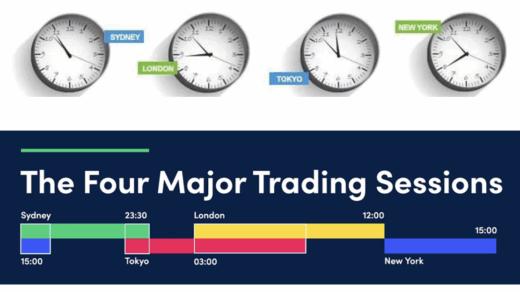The Fibonacci tool is arguably one of the most underutilized assets in a trader’s arsenal. In this comprehensive guide, we will explore the major Fibonacci trading strategies used by professional traders to pinpoint high-probability entries and exits.
Whether you’re looking to add an extra layer of confluence to your current trading system or completely overhaul your strategy, this article is for you. Mastering these techniques will significantly boost your performance in Forex, stock, or crypto markets.
Strategy #1: Fibonacci Retracement + EMA Strategy (Best for Day Trading)
This Fibonacci Retracement strategy is perfect for day traders. It combines the Fibonacci tool to identify critical support and resistance levels with Exponential Moving Averages (EMAs) to confirm the prevailing trend direction.
How it Works:
- Determine the Trend: Understanding the trend provides clarity on the direction of your trade. For example, in a confirmed downtrend, you would anticipate Fibonacci key levels to act as resistance, signaling potential selling opportunities.
- Use Key EMAs: For this setup, you will use the 50 EMA and the 200 EMA. An uptrend is confirmed when the 50 EMA is above the 200 EMA, and a downtrend is confirmed when the 200 EMA is above the 50 EMA.
- Draw Fibonacci Retracements: Next, you draw the Fibonacci retracement levels in the direction of the trend to identify potential reversal zones. The 38.2%, 50%, and 61.8% levels (the Fibonacci Golden Zone) are your key levels for potential entry and exit points.
- Wait for the Retracement: Wait for the price to pull back to one of the key Fibonacci levels. Once the price reaches a level and shows a reversal signal (e.g., a bullish or bearish candlestick pattern), you enter the trade in the direction of the main trend.
Strategy #2: Fibonacci Retracement + Support & Resistance Confluence
Trading basic Support and Resistance (S&R) is already profitable, but adding the Fibonacci Retracement tool as a confluence factor can significantly increase your win rate.
How it Works:
- Identify S&R: First, identify and mark key Support and Resistance zones on your chart.
- Draw Fibonacci Retracements: Then, overlay the Fibonacci Retracement levels to confirm these key S&R areas. The 38.2%, 50%, and 61.8% levels should align closely with your identified S&R zones.
- Wait for Confluence: Wait for the price to retrace to an area where a strong S&R level converges with one of the key Fibonacci levels. This high-confluence zone offers an excellent opportunity to enter a trade following the existing trend. This strategy is also effective for trading breakouts in these high-confluence regions.
Strategy #3: Fibonacci Extension + Trendline Strategy (Targeting Profits)
Combining the Fibonacci Extension tool with a Trendline or channel is one of the best ways to accurately determine profit targets in the Forex market.
How it Works:
- Identify Trend & Entry: Begin by identifying the trend and potential entry points by drawing a Trendline connecting the price swings (troughs for an uptrend, peaks for a downtrend).
- Draw Fibonacci Extensions: Use the Fibonacci Extension tool to project potential price targets for the current trend. Draw the Extension from the beginning of the impulse move (swing low/peak) to the end of the impulse move (swing high/trough), and back to the retracement point.
- Find Exit Targets: Look for potential exit points (Take Profit) at the key Fibonacci Extension levels. Common profit targets are the 61.8%, 100%, or 161.8% Fibonacci Extension levels.
Strategy #4: Fibonacci Arcs + Pivot Points Strategy (Intraday Forex)
In this intraday Forex trading strategy, we use Fibonacci Arcs in combination with Pivot Points to identify potential dynamic support and resistance levels.
How it Works:
- Determine Pivot Points: Calculate the daily Pivot Points based on the previous day’s high, low, and closing price.
- Draw Fibonacci Arcs: Draw the Fibonacci Arcs by using a swing peak and a swing trough as the anchor points.
- Identify Entries: Use the resulting Fibonacci Arcs as dynamic support and resistance levels. Depending on the market trend, traders look for buying/selling opportunities at the 38.2%, 50%, or 61.8% Fibonacci Arc levels, especially where they intersect with the daily Pivot Points (or R/S levels derived from them).
- Set Stops: Set your Stop Loss just above the previous day’s high for short trades, and just below the previous day’s low for long trades.
Strategy #5: Fibonacci Extension + Ichimoku Kumo Twist Strategy
The Ichimoku Cloud’s “Kumo Twist” is a popular technical scalping signal used to identify potential trend reversals across any timeframe.
How it Works:
- Confirm Trend with Ichimoku: First, determine the trend direction based on the price’s position relative to the Ichimoku Cloud (Kumo). Above the Cloud is bullish; below the Cloud is bearish.
- Draw Fibonacci Extensions: Next, draw the Fibonacci Extension tool using the swing high and swing low of the impulse move. In a downtrend, you draw the extension from the peak to the trough.
- Find Entry/Exit: Use the Fibonacci Extension levels as dynamic support and resistance to find potential entries and exits.
- In a bearish trend, when the price breaks below the Cloud and a Kumo Twist (cloud switch) occurs, consider a short entry, placing the Stop Loss above the cloud.
- Exit when the price reaches the 61.8%, 100%, or 161.8% Fibonacci Extension levels. The opposite rules apply for a bullish trend.
Strategy #6: Fibonacci Retracement + Bollinger Bands Strategy
This strategy leverages the power of Fibonacci Retracement levels as key reversal zones and Bollinger Bands as a volatility filter.
How it Works:
- Identify Key Fib Levels: Traders first identify the critical Fibonacci Retracement levels (typically 38.2%, 50%, and 61.8%) of the previous price move.
- Add Bollinger Bands: Next, add the Bollinger Bands indicator to the chart. Bollinger Bands help traders visualize the upper and lower boundaries of market volatility.
- Wait for Confluence Signal: When the price approaches a key Fibonacci Retracement level, the trader waits for the price to simultaneously touch the upper or lower band of the Bollinger Bands.
- If the price is at a retracement level and touches the Upper Band, it suggests a potential selling (short) opportunity (often in an uptrend that is overextended for a correction).
- If the price touches the Lower Band, it suggests a potential buying (long) opportunity.
- Confirmation: Traders often use secondary indicators like the RSI or MACD to confirm the trading signal at this confluence point.
Strategy #7: Elliott Wave + Fibonacci Retracement Strategy (Advanced)
Combining the Fibonacci Retracement tool with the Elliott Wave principle creates a powerful, advanced trading strategy focused on predicting the magnitude of market corrections.
How it Works:
- Identify Elliott Wave Structure: Use Elliott Wave theory (often with a Zigzag indicator) to identify the major market trend and the current wave count. Elliott Wave theory posits that prices move in five impulse waves in the direction of the main trend, followed by three corrective waves.
- Predict Correction End: Use the Fibonacci Retracement tool to forecast the potential end of the corrective waves (Wave 2 or Wave 4). Wait for the price to pull back to a key Fibonacci level (e.g., 50% or 61.8%), which is likely to act as support or resistance.
- Execute Trade: Place a buy or sell order at the predicted Fibonacci reversal level.
- Stop Loss (Long Trade): Set below the previous swing low.
- Stop Loss (Short Trade): Set above the previous swing high.
- Take Profit: Target the projected level of the next impulse wave in the Elliott Wave sequence.
Conclusion: Leveraging Fibonacci for Profitability
Fibonacci tools are incredibly powerful technical analysis indicators that can simplify your analysis and significantly enhance your profitability.
By integrating these tools with other technical indicators—such as EMAs, Support and Resistance levels, Trendlines, and Pivot Points—you can create multiple high-probability trading strategies.
Practice is essential: Before committing to live trading, it is vital to rigorously practice these Fibonacci trading strategies in a demo account. This will build confidence in your trading decisions and dramatically improve your chances of success in the market.




